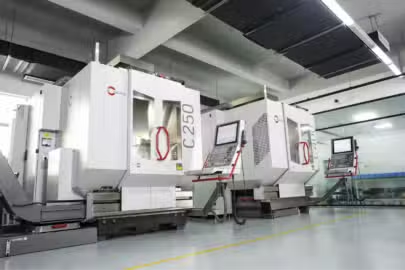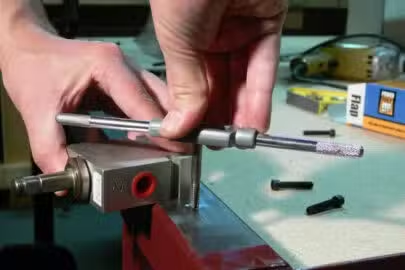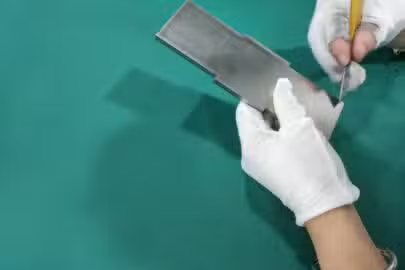The concept of machining has developed during the last few years. Simple machining methods and tools have given way to more complicated and sophisticated ones. 5-axis machining is one of the most modern machining processes available today.
However, when most people think about 5-axis CNC machining, the first thing that comes to mind is advanced technology, an expensive price, and difficulty to operate, but is 5-axis machining like this? This guide answers this question and other important information about this type of machining.
What Is 5 Axis Machining?

This process requires the simultaneous movement of cutting instruments along five axes. To create complicated pieces, 5-axis CNC machines include three linear axes that work in tandem with two rotational axes. This often increases the tilt of the worktable or tool spindly, allowing for additional rotation and mobility.
Machinists can produce up to 5 faces in a single process using a 5th axis. As a result, the process is extremely efficient and exact. It’s also ideal for building complicated structures and features with minimum setup. This technology is becoming more important for various sectors since various items require consistent machining of five faces.
Let’s first go over what an axis count in CNC machining means to better grasp the axes of the 5-axis milling machine. Machining axis count refers to the number of directions the cutting tool (or raw material) can move to produce the desired product. Conventional CNC machines, for example, have three axes. Their cutting tools can, therefore, only be moved along the X, Y, and Z axes.
The cutting tool moves in three directions: back and forth on the Z-axis, vertically on the Y-axis, and sideways on the X-axis. Through tilting and rotating the worktable, 5-axis machining centers enhance the functionality of the linear axes. The A and C-axis are two additional rotational axes. The B-axis is used for table rotation, while the A-axis is the tilting table axis. Compared to 2- or 3 axis CNC machines, including extra axes enables the cutting of more complex geometries. The axes’ movement is summarised in the table below.
What Does the “5” in the 5 Axis Stand For?
The 5 in 5-axis refers to the fact that machines used for 5-axis machining add two additional axes to the standard three axes—X, Y, and Z—for a total of five axes. A rotation around the X axis is indicated by the fourth axis, the B axis, and a rotation around the Y axis.
The kind of work a machine can perform and the amount of detail it can cut are improved by this extra axis.
5-Axis – Possible Configurations
One of the three rotational axes of the 5-axis CNC Milling Machine will be utilized depending on the configuration you select. A trunnion-style machine and a swivel-rotate-style machine are the two primary configurations.
The A and C axes of a trunnion-style 5 axis CNC mill machine rotate around the X and Z axes, respectively, whereas a swivel-rotate-style 5 axis CNC milling machine rotates the B and C axes about the Y and Z axes, respectively.
The primary distinction between the two is how the rotary axes are expressed: the 5-axis CNC Milling Machine’s swivel-rotate style expresses the rotary axes through spindle swiveling, while the trunnion-type moves the table. Since each has benefits, choosing which to utilize primarily relies on the task at hand.
How Does a 5-Axis CNC Machine Work?
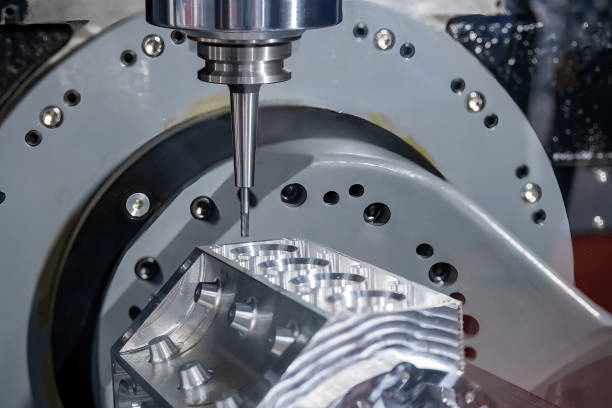
A 5-axis CNC machine requires little human involvement to operate autonomously. Material put on the machine platen is shaped using rotary cutting tools.
But the last step in the 5-axis CNC machining process is positioning the material on the platen. Creating a CAD design of the product and converting it into CAM is the first stage in 5-axis CNC machining. Software for computer-aided manufacturing, or CAM, is used to create G-code or CNC alphanumeric language.
Uploading the G-code onto the 5-axis CNC machine is the next step in the procedure. Because it includes instructions that would guide the machine on the toolpath and the appropriate tool for cutting, the G-code is extremely significant.
Benefits of 5-axis Machining
Over half of all CNC parts require 5-sided machining, which is why more and more manufacturers are including it in their services. Furthermore, when compared to 3-axis machining, 5 axis CNC machining provides numerous advantages, including:
Effective Setup Operations
Setting up a 5-axis CNC machine is less complicated than setting up a 3-axis machine. The reason for this is that 5-axis CNC machines can work on five surfaces at the same time. Furthermore, 5-axis machines can produce curved pieces with a single structure. However, various setups are required for standard 3-axis devices to work on several faces.
Machine Complex Shapes
Adding one axis to this machine simplifies the manufacturing of complex patterns and geometries. Machining challenging angles and arcs, which formerly required many unique fixtures, is now possible with 5-axis CNC machines. Furthermore, the capacity of this machine to rotate pieces during a single operation allows for the creation of required geometries without sophisticated machines or fixtures.
High Precision and Repeatability
Manual machining techniques require additional settings to ensure optimal machining. These additional settings, however, frequently contribute to design variability and mistakes, causing machinists to lose alignment during milling. However, 5-axis CNC cutting requires fewer settings, which reduces the risk of errors while increasing accuracy.
Furthermore, most 5-axis CNC machines machinists use nowadays eliminate the necessity for human repositioning of the workpiece during milling. This ensures better machining tolerances. Furthermore, in some machine settings, adopting shorter cutting tools increases tool longevity while ensuring reproducibility.
Single Setup
Because 5-axis CNC machines have five axes, you may set up your workpiece once, and the machine will handle every machining operation required to manufacture your desired product. This contrasts traditional 3-axis machines, which require multiple machine configurations to manufacture complex geometry.
The single-setup nature of 5-axis CNC machines enables you to make complicated parts fast while lowering costs and eliminating faults common in traditional CNC machines.
High Production Efficiency
5-axis machining can significantly reduce part machining and auxiliary time. It involves a wide range of spindle speeds and feed rates, allowing the machine to conduct a powerful huge cutting capacity. 5-axis CNC is entering a new era of high-speed machining. The quick movement and positioning of 5-axis machining, as well as high-speed cutting processing, shorten the turnaround time for semi-finished goods.
Quality Surface Finish
The availability of additional axes results in a finer surface finish with a 5-axis CNC machine. These extra axes bring the compnenets closer to the cutting tool, thereby making it easier to achieve the desired shapes. It also allows for the use of shorter machining tools.
There is little to no vibration with shorter cutting tools, which reduces the occurrence of marks on the surface of produced goods. Furthermore, while using the vertical machining method, spindle utilization improves for miller inclined surfaces.
Drawbacks Of 5-Axis CNC Machining
The 5-axis has several advantages and is very important in the manufacturing of parts. However, not all is rosy with 5-axis machining since certain disadvantages exist. The following are the disadvantages of 5-axis machining:
Increased Cost
The cost of getting a 5-axis CNC machine is significantly more than that of acquiring a 3-axis machine. The same is true for the software required to run this system. Furthermore, 5-axis CNC machine maintenance is more complicated than CNC machine maintenance. As a result, one of the biggest disadvantages of employing 5-axis CNC machines for milling is the expense.
Programming Complexity
Programming for 3-axis machines differs from programming for 5-axis machines. This is mainly owing to the addition of two rotational motions, which complicates the synthetic motion’s trajectory.
To minimize collision and interference, programming the 5-axis would have to consider each axis’s distinct motion. Furthermore, improving surface quality and precision necessitates more complicated programming.
High Level of Operator Skill is Required
5-axis CNC machining utilizes cutting-edge technologies. A highly-skilled technical operator is necessary to get the most out of the equipment. Hiring a highly skilled operator, on the other hand, enhances labor costs.
Types Of 5-Axis CNC Machines
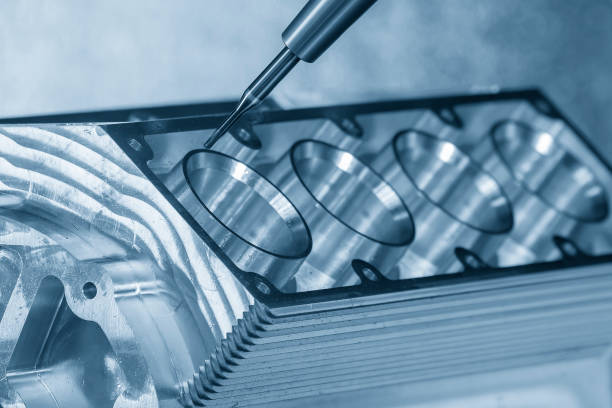
5-axis machines can improve machining efficiency and scalability. To fulfill the needs of the manufacturing industry, these machining centers might be of numerous types. There are three main types of 5-axis CNC machines:
Head/Head
Rotational axes are situated in the head of head/head machines. Their 5-axis apex is mounted on a platform that moves through a stationary worktable while holding the workpiece in position. As a result, there will be no tool interference on the machine spindle head.
This increases the apex’s ability to move around a workpiece, making it appropriate for creating massive, heavy pieces. The machine table can resist big weights without impairing the rotational aces’ accuracy. However, the architecture of these devices restricts their rotating axis movements.
Head/Table
The head/table machine configuration features one rotational axis in the head and one in the rotary table. Their revolving axis is located in the brain and has a limited range. The rotating shaft, on the other hand, has a larger (infinite) range and is positioned in the table.
This configuration is advantageous since it can spin the workpiece indefinitely. However, the quantity of parts it can make is limited. This is because the rotary axis supports the workpiece.
Table/Table
The 5-axis machines’ rotating axes are located inside the table in this configuration. As a result, all rotations occur on the table, and the head does not move. These machines’ design makes them ideal for cutting undercuts. Furthermore, because the head does not rotate, machinists can immediately observe how the cuts will occur during the programming step.
However, the machine configuration could be better for milling or CNC turning large or heavy components. This limitation is due to the table’s inability to withstand excessive weight.
What Type Of Parts Can Be Machined Using A 5-axis Machining Center?
5-axis CNC machining produces a wide range of products. These parts frequently have complex geometries and intricate forms. Here are some examples of 5-axis machining parts:
Special-Shaped Parts
Parts with irregular shapes are referred to as unique-shaped parts. Workpieces have a mix of points, surfaces, and lines, for example. Because of the difficulties in controlling the clamping pressure during the process, cutting such parts using conventional machining is difficult or near impossible. However, with 5-axis machining, using a multi-station point makes the procedure easier to finish.
Because of the repeated clamping and alignment required, using standard machining equipment on box-shaped items is relatively challenging. The flexibility of a 5-axis machine to work on many surfaces at once makes it easier to produce higher-precision box-shaped pieces.
Box Type Parts
Because of the repeated clamping and alignment required, it is difficult to use standard machining equipment on box-shaped items. The ability of a 5-axis machine to work on many surfaces simultaneously makes it easier to produce higher-precision box-shaped pieces.
Disc Parts
5-axis CNC machining is also perfect for machining UAV parts. It is ideal for cutting plate parts and plats, particularly those having end-face distribution holes or radial holes. It is also suitable for producing machine motor covers. It is vital to note that applying 5-axis CNC machining to such objects necessitates using either a horizontal or vertical machining center. The exact hole direction determines the machining center selected.
Complex Surface Parts
Complex surface parts are common in several industries, including aviation, aerospace, and electronics. It is tough to achieve this intricate surface with standard CNC machine equipment. Spherical surfaces, turbine engine blades, marine propellers, impellers, and other complicated surfaces produced via 5-axis machining are examples.
Useful Tips To Get The Most From 5-Axis CNC
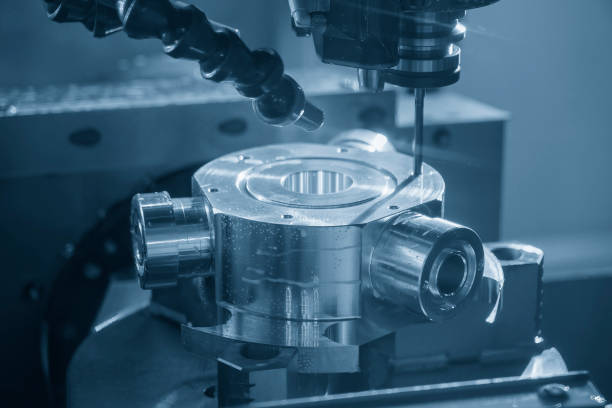
Here are some valuable tips to grab that will help you in reaping the benefits of this production process:
Select the Right Controls and Software
Try to gather as much information as possible before adopting 5-axis technology. Analyze the customer’s data, making sure it’s accurate and correct. Examine the component carefully to determine whether a pretest is required.
Before turning the CAD design into a CAM model, simulation software will be helpful for evaluating the procedure. The program will assist in monitoring the tool’s length, interference, and part size. It is necessary to invest in programs and software that supplement the capabilities of the 5-axis machine. It’s also a good idea to conduct a cost analysis to verify you’re employing the most cost-effective technique for the work.
Choose a Tool-detection System
5-axis CNC machining ensures high productivity but may increase error risks. This could be due to using the incorrect tool or having a faulty cutting tool. Such errors can be minimized by using a tool-detection system. This technique will assist you in analyzing the tool you wish to utilize, ensuring you select the correct one.
Avoid Collisions
Creating 5-axis tool paths frequently requires a general trade-off between high-speed cutting and limiting accident hazards. Collisions might create defective components, damage the machine, or force you to trash pieces.
Fortunately, specific software tools can eliminate this. The software program will anticipate every tool movement to see if it will collide with anything. As long as the CNC machining design is modeled correctly, the program will detect the collision before it occurs.
Run the Kinetics
Running kinetics will boost the accuracy of the specifications for each feature. It will assist you in understanding the proper arrangement of the cutting tools and the turning points of the axes.
Applications Of 5-Axis CNC Machining
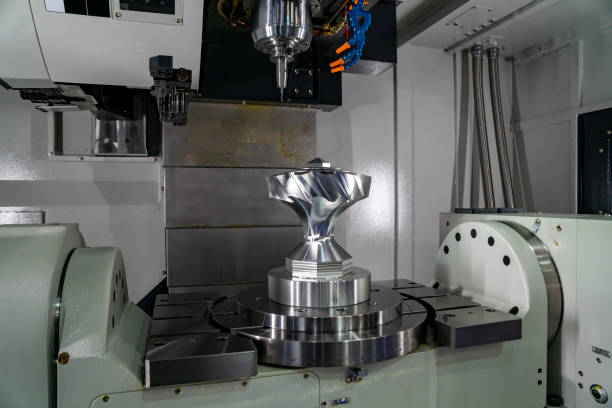
Because of its efficiency and capacity to generate complicated shapes, 5-axis CNC machining can be used to produce parts used in a variety of sectors. Here are a few examples of industries that frequently use this technology:
- Medical-5-axis CNC machining can assist medical equipment makers in developing gadgets, implants, and other equipment that require extra precision to meet strict (and correctly so) healthcare requirements.
- Energy equipment– It produces rapid prototyping parts for energy equipment that often require using materials that are difficult to work with. You can make the whole process easier and more efficient with 5-axis CNC machining.
- Aerospace– Because the shapes are so detailed and distinctive, this industry requires precise equipment.
- Military- This sector generates the necessary pieces by 5-axis CNC machining. Submarine components, high-performance engine parts, turbine and compressor blades, smart weapons, sensors, stealth applications, and, in some situations, nuclear weapons are a few of the potential uses.
Get Started With 5-Axis Machining At Zintilon
Now that 5-axis CNC machining has been discussed, you have a thorough understanding of it. Now is the moment to take control of your manufacturing encounter. Five-axis CNC machines increase precision and accuracy, expedite and lower manufacturing costs, and streamline fabrication processes. They are not, however, perfect for every design. For example, precise cutouts, holes, and cavities might be better suited and more affordable for 3- or 4-axis CNC machines.
Therefore, before beginning your project, it is crucial to speak with a CNC machining specialist. Globally, Zintilon is a top supplier of CNC machining services. We produce high-precision CNC machined parts with excellent quality, quick lead times, and affordable prices thanks to our CNC machining services.
To assist you in selecting from our selection of production-grade materials and machining technologies, our highly qualified professionals also provide technical support. Get in touch with us right now to talk about your project. To receive a free DFM analysis and an instant interactive quotation, upload your design file to our website for instant quotes.
Conclusion
5-axis CNC machining makes it possible to produce complicated items with a high-quality surface finish. Despite its high initial cost, this machining saves money and time in the long run. It is a machining method with applications in several industries, including aerospace, electronics, and the medical industry, due to its highly precise parts.


